BIOGRAPHY - page 1
The child later known as Stakar was born in the near future of an alternate timeline, Earth-691. In this reality, Earth was conquered by the Martian Masters, an extra-stellar race who used Earth’s closest neighbor as a staging ground for their attack on the planet. Stakar’s father was Wendell Vaughn, the Protector of the Universe and wielder of the Quantum Bands known as Quasar. His mother was the genetically-engineered human known as Kismet, or sometimes simply “Her.” As the War of the Worlds began, Quasar was unable to stop the Martian tripods from attacking his hometown in Oshkosh, Wisconsin, leading to the deaths of his mother and sister. When he learned Kismet was pregnant, and she fainted from the strain, Wendell sought to protect the only family he had left.
Quasar used his bands to quantum jump away from Earth with Kismet, removing her from the field of battle and traveling to the planet Vesper. The intergalactic Sisters of Mercy promised to care for Kismet during her pregnancy and ensure the child came to term. Quasar tried to return to the 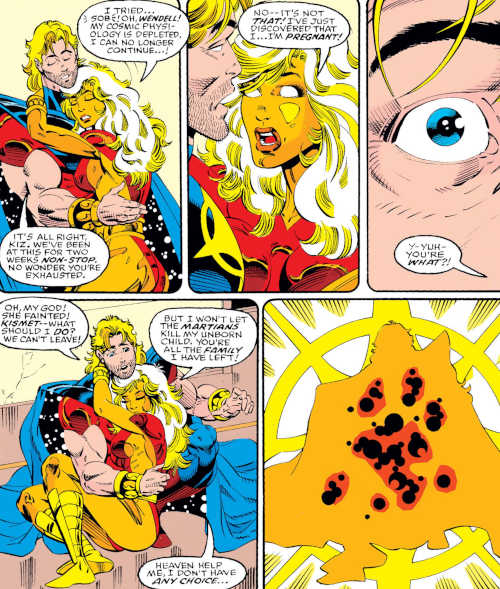 War of the Worlds but was diverted en route and died facing the mysterious Abrogate. Kismet delivered a son on Vesper, but the baby was wrenched from her grasp almost immediately by the enigmatic cosmic entity called Eon, purportedly Quasar's patron as the Protector. Having nowhere else to go after Earth fell and Quasar failed to return, Kismet remained as one of the Sisters of Mercy, grieving her lost child. For reasons known only to them, Eon deposited the infant child onto the planet Arcturus. [Guardians of the Galaxy (1st series) #61-62]
War of the Worlds but was diverted en route and died facing the mysterious Abrogate. Kismet delivered a son on Vesper, but the baby was wrenched from her grasp almost immediately by the enigmatic cosmic entity called Eon, purportedly Quasar's patron as the Protector. Having nowhere else to go after Earth fell and Quasar failed to return, Kismet remained as one of the Sisters of Mercy, grieving her lost child. For reasons known only to them, Eon deposited the infant child onto the planet Arcturus. [Guardians of the Galaxy (1st series) #61-62]
On Arcturus, the population was separated into the aggressive and war-like Reavers (who were human in appearance) and the Mutants (who varied dramatically from one specimen to another). A Reaver named Ogord took part in a raid on the Mutant settlement where Stakar’s infant form 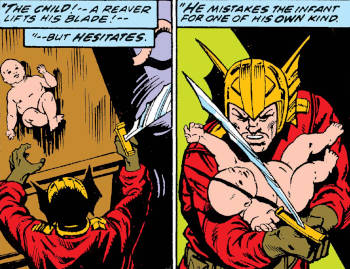 rested inside a nutrient tank. Ogord killed the Mutant couple who emerged from the same building and mistook them for Stakar’s parents. He found what appeared to be a completely normal Reaver baby among the Mutants and hesitated before killing it. The infant Stakar did not cry out and Ogord misinterpreted this as a sign of innate courage. He adopted the child as his own, naming him Stakar. The boy was raised alongside Ogord’s natural daughter Aleta, fully aware he had been adopted but believing he was naturally born as an Arcturian Mutant.
rested inside a nutrient tank. Ogord killed the Mutant couple who emerged from the same building and mistook them for Stakar’s parents. He found what appeared to be a completely normal Reaver baby among the Mutants and hesitated before killing it. The infant Stakar did not cry out and Ogord misinterpreted this as a sign of innate courage. He adopted the child as his own, naming him Stakar. The boy was raised alongside Ogord’s natural daughter Aleta, fully aware he had been adopted but believing he was naturally born as an Arcturian Mutant.
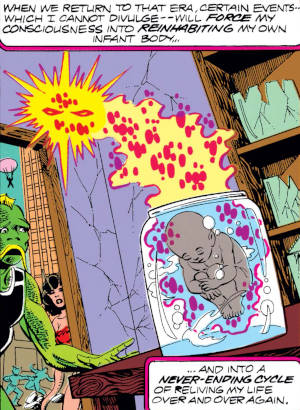
What seemed like courage as an infant was eventually revealed as apparent apathy, though. Stakar was incredibly passive growing up, a trait which made him a disappointment to the militant Ogord and his family. His adopted sister Aleta was a Reaver-born, aggressive and eager to prove her mettle in combat once she came of age. Aleta was disappointed in the weakness she saw in Stakar. It seemed as if Stakar lacked the killing instinct necessary for becoming a full-fledged member of the Reavers, but the truth was far more complicated. Centuries in the future, at the moment of his death, Stakar’s consciousness was destined to be transplanted back in time, where it would inhabit his infant form shortly before Ogord’s arrival. Stakar grew to adulthood with full knowledge and awareness of his own future, only to see it unfold again up until his mind was sent back in time.
Over. And over. Again.
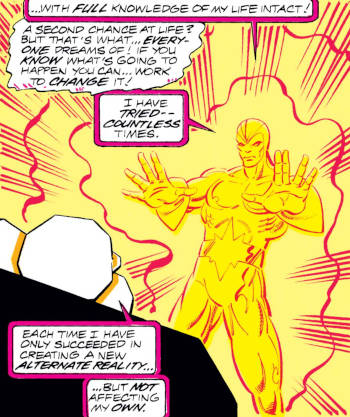 Time after time, Stakar attempted to change his fate or avoid his personal tragedies, only to discover the major elements of his life were fixed points in the timestream. Even when his memory faded of a particular event, or he succeded in changing small details, the inevitable cycle of death and reincarnation would continue. By the current timeline, Stakar had lived his life dozens, perhaps even hundreds of times over. He became resigned to the cage of destiny that surrounded him and no longer struggled against the bars. He merely lived out his life as he knew it would unfold in a sullen and detached manner. In a small gesture of wit, Stakar allowed himself the title as The One-Who-Knows, leading others to assume he carried the prestige of clairvoyance or cosmic awareness. Despite all they shared, even Aleta would not learn the secret of his foreknowledge for a millennium.
Time after time, Stakar attempted to change his fate or avoid his personal tragedies, only to discover the major elements of his life were fixed points in the timestream. Even when his memory faded of a particular event, or he succeded in changing small details, the inevitable cycle of death and reincarnation would continue. By the current timeline, Stakar had lived his life dozens, perhaps even hundreds of times over. He became resigned to the cage of destiny that surrounded him and no longer struggled against the bars. He merely lived out his life as he knew it would unfold in a sullen and detached manner. In a small gesture of wit, Stakar allowed himself the title as The One-Who-Knows, leading others to assume he carried the prestige of clairvoyance or cosmic awareness. Despite all they shared, even Aleta would not learn the secret of his foreknowledge for a millennium.
And so, as it always began, Stakar as a young man chose to journey out into the ruins of the Forbidden City on Arcturus. Aleta warned Stakar against breaking their society’s rules, but 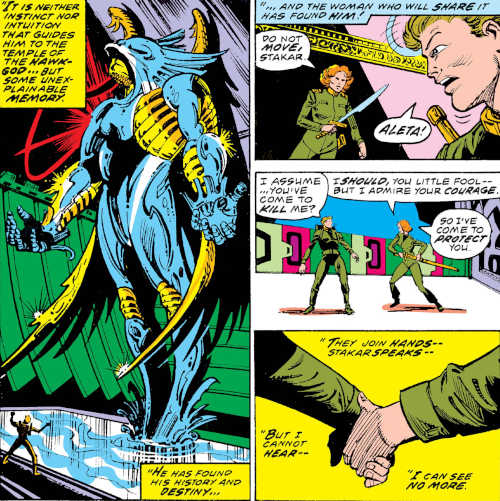 ultimately followed her weakling of a brother to make sure he didn’t harm himself. Stakar discovered the lost temple of the Hawk-God, a war-like deity once worshipped by the Arcturians and which had fallen into obscurity. Stakar believed a discarded brain-wave helmet was the key to accessing the lost knowledge of the ancient Arcturians and spent days trying to fix it. Aleta came to appreciate Stakar’s quiet courage for venturing into the unknown, but she grew impatient with his tinkering. When a Reavers’ patrol came looking for them, Aleta interrupted Stakar’s work and smashed the helmet in order to get his attention.
ultimately followed her weakling of a brother to make sure he didn’t harm himself. Stakar discovered the lost temple of the Hawk-God, a war-like deity once worshipped by the Arcturians and which had fallen into obscurity. Stakar believed a discarded brain-wave helmet was the key to accessing the lost knowledge of the ancient Arcturians and spent days trying to fix it. Aleta came to appreciate Stakar’s quiet courage for venturing into the unknown, but she grew impatient with his tinkering. When a Reavers’ patrol came looking for them, Aleta interrupted Stakar’s work and smashed the helmet in order to get his attention.
The damaged helmet exploded with energy and destroyed Aleta’s physical form. Her essence was then absorbed into the statue of the Hawk-God, animating it as a war-engine of incredible destructive power. The Hawk-God took to the skies and began to wreak havoc over Arcturus, easily swatting the Reaver airships that tried to counter-attack. Stakar repaired the brain-wave helmet and used it to make contact with Aleta’s mind inside the Hawk-God. Stakar was drawn inside the mixture as well, triggering a multi-nuclear explosion and implosion as Stakar, Aleta and the Hawk-God merged to become one being. The statue was, in fact, the Hawk-God himself, condemned by cosmic justice to remain immobile and forgotten on Arcturus for millennia. He thanked his “children” for awakening him and restored them as his avatar with a new body containing great power.
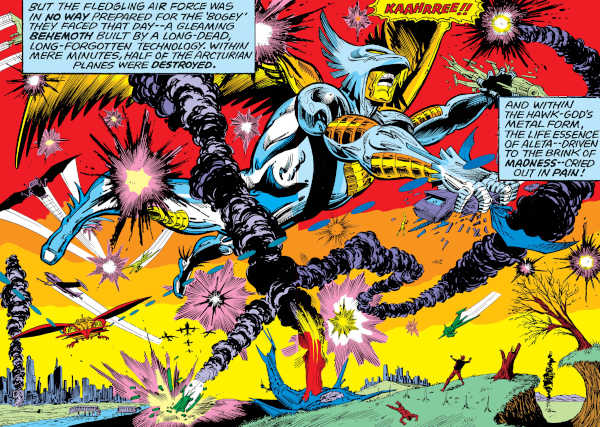
Stakar emerged from the aftermath of the blast, transformed into a new being called Starhawk. He and Aleta now occupied a singular energy form cast into human shape. Only one of them could exist at a time, transfiguring their shared body between their two forms as one mind or the other became active. The other partner existed in a featureless limbo between activation periods, unable to observe the outside world or communicate with it. As “The Light and the Giver of Light,” Stakar possessed immense talent for manipulating and expressing the coherent light energy that 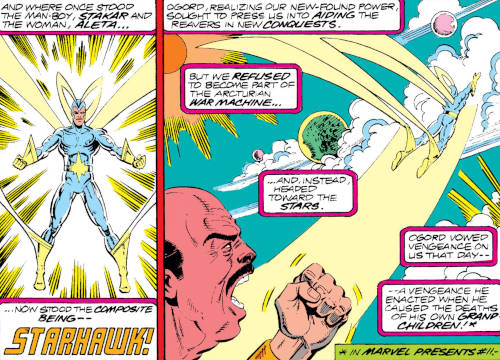 defined their new form, but it was Aleta who generated the light energy which sustained them, tying them together forevermore. Having touched the wisdom of the Hawk-God, Aleta was changed by the experience and chose a path of peace instead of the war-like nature of her people. Having found a purpose, even “Knowing” it was one to which he was shackled, Stakar embraced his new role as Starhawk. Together they rejected Ogord’s attempt to harness them as a weapon for the Reavers and turned their back on the only homeworld they had even known. [Marvel Presents #9-10, Guardians of the Galaxy (1st series) #7]
defined their new form, but it was Aleta who generated the light energy which sustained them, tying them together forevermore. Having touched the wisdom of the Hawk-God, Aleta was changed by the experience and chose a path of peace instead of the war-like nature of her people. Having found a purpose, even “Knowing” it was one to which he was shackled, Stakar embraced his new role as Starhawk. Together they rejected Ogord’s attempt to harness them as a weapon for the Reavers and turned their back on the only homeworld they had even known. [Marvel Presents #9-10, Guardians of the Galaxy (1st series) #7]
[Note: The origin from Marvel Presents #9-10 identified the Hawk-God as a robot run amok by Aleta’s actions, and Stakar’s immense knowledge was a download of information from the brain-wave helmet repaired. GotG #7 re-framed the scene to make the Hawk-God a genuine patron deity of the duo, and first provided the time-loop explanation for The One-Who-Knows. Many years later, Infinity Countdown: Darkhawk #3 gave the Hawk-God a name (Ra’Thakon) and detailed how a specific ritual of two sacrifices, one willing and one unwilling, was a traditional method of evoking the Hawk-God’s power for an avatar.]
Stakar and Aleta traveled together as Starhawk through space for centuries. Even though they were unable to communicate with each other most of the time, the bond between them created by their union was strong. Though there had never been a recognized ceremony, the couple considered each other husband and wife through the intimate merger they experienced. Ogord never forgave his children for refusing to lend their power to the Reavers’ service, and it didn’t help that they occasionally helped protect other species from the Reavers’ space pirate fleet.
At some point, probably shortly before the end of the 30th century, Stakar and Aleta discreetly returned to Arcturus. With the blessing of the Hawk-God, they split for the first time in order to conceive, and Aleta would give birth to their three children, John, Sita and Tara. Using their powers, Stakar constructed a space habitat for their family which resembled a simple farmhouse. Starhawk merged once more and Stakar gave way to Aleta for many years, so that the mother  could begin raising their children in this peaceful, isolated locale. The urge to wander the spaceways resurfaced in time, and Aleta surrendered the body back to Stakar so Starhawk could resume his travels. All three children were adolescent or pre-adolescent at this point, able to care for themselves in the relative tranquility of the habitat. Stakar added a transparent faceplate to his cowl which allowed him to communicate with the children over great distances. They also crafted a computer for the children which shared an empathic link to Aleta. She could monitor the children and they in turn could signal her even when Starhawk was the dominant partner.
could begin raising their children in this peaceful, isolated locale. The urge to wander the spaceways resurfaced in time, and Aleta surrendered the body back to Stakar so Starhawk could resume his travels. All three children were adolescent or pre-adolescent at this point, able to care for themselves in the relative tranquility of the habitat. Stakar added a transparent faceplate to his cowl which allowed him to communicate with the children over great distances. They also crafted a computer for the children which shared an empathic link to Aleta. She could monitor the children and they in turn could signal her even when Starhawk was the dominant partner.
